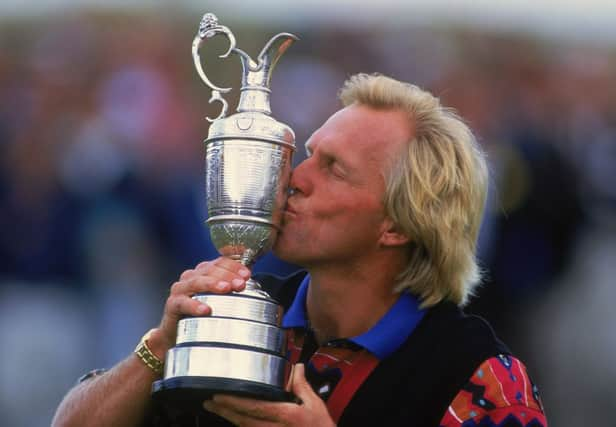Archive: Greg Norman proves he is no ‘quitter’


The Scotsman, 20 July 1993
BOBBY LOCKE, who won the first of his four Open championships at Royal St George’s in 1949, was wont to dismiss carping criticism by saying: “It’s the tall trees that catch the wind.”
In the South African’s case, the critics were often American players resentful that a foreigner was successfully plundering what they regarded as their private preserve.
Advertisement
Hide AdAdvertisement
Hide AdThe fact that his putting bordered on the supernatural probably didn’t help either.
As trees go, Greg Norman, the new Open champion, has borne the full brunt of a veritable gale for some time now and borne it with dignity, courage, and a sense of proportion that has never failed him.
He has never, in the course of many press conferences after many ordeals, referred to bad luck. That is quite a feat, taking into consideration all that has befallen him.
Not only has he had several majors denied him, in some cases due to his own failings, but certainly two because Bob Tway and Larry Mize holed outrageous shots at crucial moments.
As if things weren’t bad enough, golfers on the US Tour picked up on what was fast becoming all the rage, and in 1990 he was foiled in the USF&G Classic by another holed bunker shot this time by David Frost.
Around the time Robert Gamez pipped him in the Nestle Invitational, by holing a full 7 iron shot for a winning eagle, Norman had resigned himself to the day when the opposition would start holing their drives. Quite unfairly, he was regarded in certain quarters as being a “quitter”– a golfer who stopped just short of greatness because of a lack of ability to produce his best in the moments of truth at the very highest level.
No-one who witnessed his 63 on the way to winning at Turnberry in 1986 would have much truck with that view, though the three putt with which he ended that round was a curiously Normanesque lapse (the 17th on Sunday provided another). A small, and in that instance, inconsequential tremor at a time when he was looking positively invincible.
Something similar also happened at the seventh on Sunday.
Rather unluckily, Norman’s ball had died left, and off the green.
Advertisement
Hide AdAdvertisement
Hide AdFrom my vantage point, or disadvantaged as it turned out, it looked as if he was chipping from the collar.
In fact, he took his putter and, with a fair amount of green to work with, spared it, and the ball came back off the slope confronting him.
The shadow of Nick Faldo lay heavily over the scene just then. The defending champion was playing right behind.
You just knew he would birdie the seventh and, in due course, he did.
There was still a lot of golf to be played.
As Norman’s ball trickled down from the crest of the fold, an audible sigh went through the gallery, an eloquent sigh that said simply: “Is it happening to him again?” The crisis was ridden, the par secured and it was back to the golf which had taken him into the lead.
It had been a glimpse of human frailty, though, and perhaps it is this very quality that makes Norman as popular as he is with the public.
Like Palmer and Ballesteros, Norman can get things wrong when you least expect it and somehow his reactions trigger a highly emotional response.
It is a quality which allows people to identify easily with him and which takes the golf of such champions into the realm of theatre.
Advertisement
Hide AdAdvertisement
Hide AdGolfers like Faldo and Langer somehow do not register their feelings in the same way. Their main attraction lies in the sheer excellence of their golf.
People tend to be surprised when Faldo drives into trees, horrified when Ballesteros does it.
Norman insists that the critics have not bothered him and that his prime aim when he goes out to tackle a tournament is to win it and prove he’s right, not to prove them wrong.
He couldn’t have proved himself more effectively than he did at Sandwich. On a course, which, in spite of the scoring, was not an easy one, he set a record aggregate and recorded the best closing round by a champion.
He was only the second champion to break par on the course, Bill Rogers being the other in 1981.
Michael Bonallack, secretary of the R&A and five times an Amateur champion, a man not easily moved to superlatives, described Norman’s play as “sensational”, pointing out that he’d never played safe, never hesitated, always gone for the driver even at the 14th after Langer had carved one out of bounds and never missed a fairway.
Faldo had been asked before the round if he would take a 67 and had replied: “Gladly.”
He did take 67 and it was two shots too many.
Norman won his title against the greatest concentration of golfing talent ever assembled in the championship.
Advertisement
Hide AdAdvertisement
Hide AdAmong the last 16 groups to go out on Sunday were 15 winners of major championships.
It was a performance of the very highest from a man whose resilience is quite extraordinary.
He lost the 1989 Open at Royal Troon by hitting an adrenalin charged drive into a bunker he didn’t think he could reach.
He lost out to Mark Calcavecchia in the play-off, yet was able to laugh about it aftewards.
Asked then if he felt golf owed him a championship, Norman shot the questioner an old fashioned look and said: “One? hell, it’s due me about four.”
At the age of 38 he’s going to have to buckle down to it if he’s to nail the other three. Like Palmer and Ballesteros, Norman gets things wrong when you least expect it and somehow his reactions trigger an emotional response, allowing people to identify easily with him.